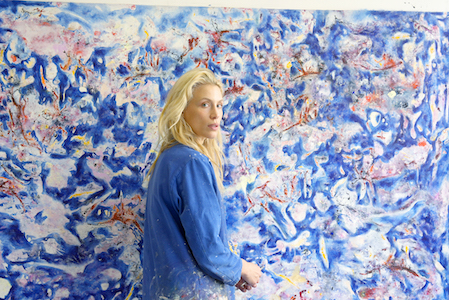Art as an archive of memory and fantasy
This year, the artist Marie de Villepin debuted Visions of Collisions, a multi-disciplinary performance created in collaboration with the choreographer Anatole Hossenlopp. As part of visionary Benjamin Millepied’s Paris Dance Project, the dynamic project fused color, sound, and movement for a comprehensive study on the nuances of human creativity and vulnerability. Villepin carries with her a childhood surrounded by influential musicians, poets, and filmmakers, resulting in a compelling sixth sense for transforming visceral emotion into poignant art.
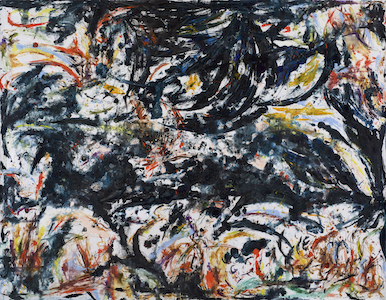
Marie de Villepin, “Visions of Collisions – Paris,” 2023; courtesy of the artist.
In March, a poetic show at Villepin Art Gallery in Hong Kong culminated by the painter, marking her first solo presentation in Asia. Titled “Murmuration,” the presentation of drawings and paintings found inspiration in the lyrical dancing of birds across the sky. One month later, in April, Villepin unveiled “Behind the Sun” at Today Art Museum in Beijing, joining an assortment of dramatic works which contemplated the dualities inherent in the celestial force, as well as our ardent desire for its nourishing energy and warmth. Throughout her oeuvre, provocative titles such as Safe as Milk (2023), Venus Fly Trap (2018), and Primitive liar, aborted frame (2016) have corresponded to stirring abstract figures and colorful expressions of fragile yet tenacious ecosystems.
Whitewall spoke with the artist to hear about freedom of creation, engraving paintings with a soundtrack, and disrupting the senses for maximum vulnerability.
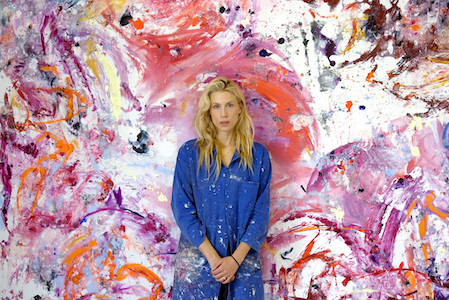
Portrait of Marie de Villepin; photo by Ivi Roberg.
WHITEWALL: How did your collaboration with Benjamin Millepied come about? What role did he play in shaping the artistic vision for it?
MARIE DE VILLEPIN: Benjamin Millepied came to visit my studio during an open studio visit we had at Poush Aubervilliers, an artist collective where 250 artists from different practices and nationalities work. He contacted me to see if I was interested in being part of his Paris Dance Project. The idea was to pair a plastic artist with a dance choreographer and get them to collaborate on a piece. I was thrilled to participate and work with Anatole Hossenlopp, a very talented choreographer. We were given total freedom of creation.
WW: What inspired you to choose this particular theme? Can you tell us about the concept of your performance?
MDV: The title of the piece is “Visions of Collisions.” It’s an homage to Van Gogh. The painting depicts the visions I imagined he had after he shot himself while standing in a wheatfield in July 1890. I wanted to try to convey, through large brushstrokes and color, the disruption of the senses, of space, of time one might feel in those final moments. Both Anatole and I wanted to do something very cinematic, and Van Gogh seemed the perfect guardian figure. We admired his expressive colors and brushwork, but above all his symbolic force.
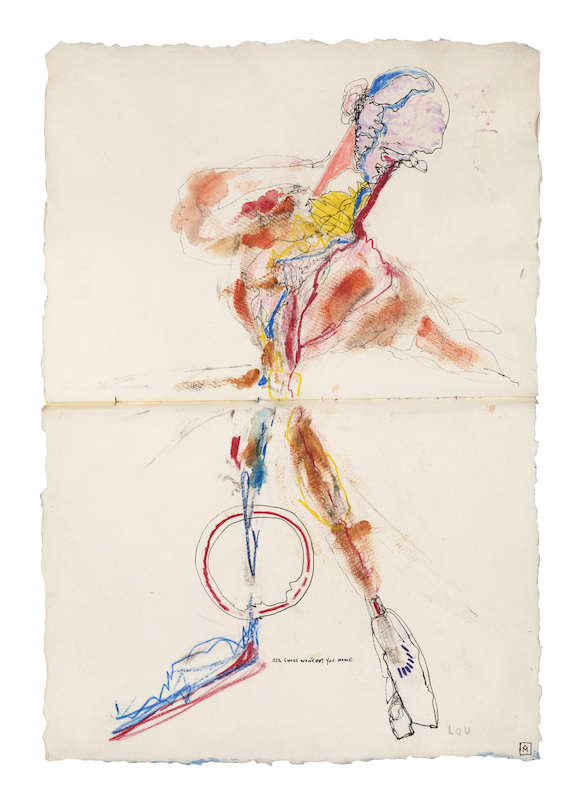
Marie de Villepin, “Lou Reed: Red shoes won’t get you home – NYC,” 2015; courtesy of the artist.
WW: Could you give us some insights into the creative process behind your artworks for this piece? What techniques or mediums did you use?
MDV: I like the constraints of oil painting since it’s a very demanding medium where often mistakes and accidents can become singularities. I worked on a large linen canvas (218 by 282 centimeters) in successive layers that required several days of drying, often blasting loud music—the same album, “The Downward Spiral,” by Nine Inch Nails on repeat. I think I drove my neighbors crazy.
I always try to engrave a specific soundtrack in my paintings. I would like people to look at my paintings as if they were reading a score, with notes that, when put together, would create an inner music. As in music, there are repetitions of motifs, alternations of sounds and silences, a rhythm that gives a texture, that transforms the space. Whatever my starting point, each painting takes on a life of its own and hopefully finds its own way.
“I like the constraints of oil painting.” —Marie de Villepin
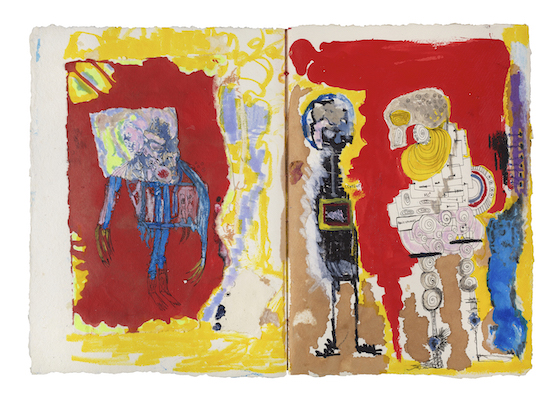
Marie de Villepin, “New Creatures – Los Angeles,” 2016; courtesy of the artist.
MDV: There are shapes that haunt me and come back, consciously or unconsciously, like evening visitors. Human silhouettes, birds, forms on the move in a primitive nature undomesticated by man. There are also imprints, traces, in a post-catastrophe world. What I paint is intimately linked to a land, a climate, a voice, people. I try to transform everything I can experience, hear, and grasp into material for creation. A painting is thus a story in its own right, a piece of a puzzle.
In the midst of all this, I try, through color and the interplay of lines and shapes, to re-establish an order in which life is possible. Beyond the themes, recurring questions assail me: how can I find the point of balance between the present moment and the passage of time? How do you capture the spirit and form of a moment, a place, an image? How do you transcribe without betraying? Hence the incessant to-and-fro between full and empty, fragmentation and crystallization, inscription and erasure.
I try not to dodge anything in order to reach a state of maximum vulnerability. From there, I launch myself onto the canvas and, step by step, I try to answer the questions that embrace me by drawing a path.
“I try not to dodge anything.” —Marie de Villepin
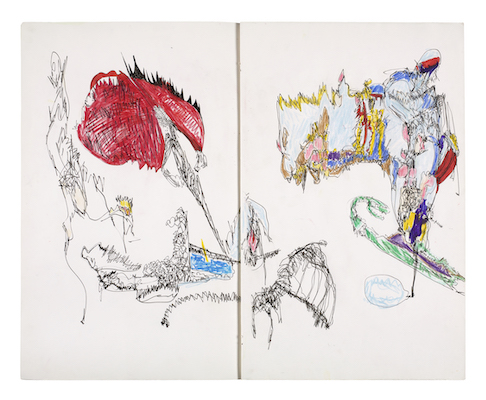
Marie de Villepin, “Venus Fly Trap – Paris,” 2018; courtesy of the artist.
WW: What do you hope viewers will take away from experiencing your performance?
MDV: Hopefully the viewers will have their senses disrupted.
WW: Were there any specific artists or movements that influenced your work for this performance? If so, how did they inspire you?
MDV: Besides Vincent Van Gogh, having lived in the United States for many years, I obviously drew a lot from its past. Painters like Jackson Pollock, Joan Mitchell, or Philip Guston, but also painters of the Art Brut, like Horace Pippin, Bill Traylor, or Henry Darger. I love these painters for their musicality, their freedom, and their capacity for transgression.
Through their examples, I’ve gained a better understanding of what I want to do, without being locked into a trend or a set of influences. What’s important to me is to translate what’s inside me, what I see, what I experience.
I draw inspiration from everywhere, from architecture and photography, such as the images of Francesca Woodman that haunt me, and the work of Sally Mann, Deborah de Turbeville, John Craven, Malick Sidibe or Seydou Keita. Likewise, I’m fascinated by the masterful shots of Maya Deren’s experimental films, where she did everything herself, the poetry of Hiroshi Teshigahara‘s films, or the madness of Alejandro Jodorowski. And then there’s the music, of course, from Charles Mingus to Kendrick Lamar, Syd Barrett, and Junior Kimbrough.
“I draw inspiration from everywhere.” —Marie de Villepin
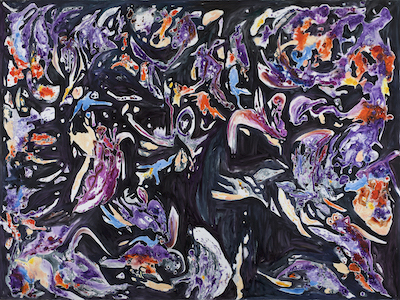
Marie de Villepin, “Vanitas”; courtesy of the artist.
WW: How does this exhibition reflect your personal artistic journey and growth as an artist? Are there any notable shifts or developments in your style or thematic interests?
MDV: A painter’s work is usually solitary, so working closely with Anatole was a real opportunity to work with another way of thinking, of creating, or simply of seeing. We have very different references and it was quite enriching for me to see him compose his movements around my painting and share our creative process together. We’ve already made plans to collaborate more in the future.
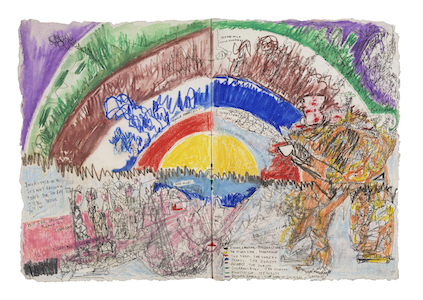
Marie de Villepin, “Let’s copyright the Sun – New York,” 2014; courtesy of the artist.



